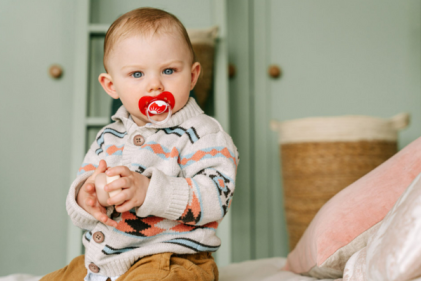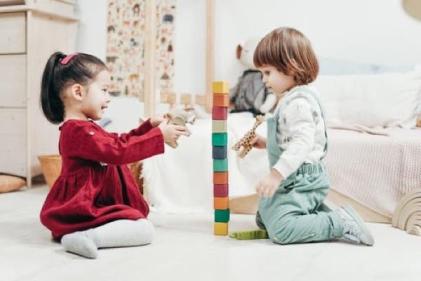From a young age, children are spoken to and treated in different ways, depending on their gender.
Baby girls are spoken to with softer, pretty sounding words and are physically handled more delicately than boys of the same age. When people compliment a girl child, they describe her as 'adorable' or 'beautiful', while boy children are praised for being 'strong' and 'robust'. A child's earliest observations and experiences of gender roles form the basis for how they expect to behave later on in life. Toys that are given to children, such as cars for boys and dolls for girls, form a permanent gender association in their minds.
When a child observes members of the family or household performing tasks and wearing clothing that is specific to their gender, they will expect other people of the same gender to behave in a similar manner. These perceptions are strong and long-lasting. If they see that only their father fixes things around the house and that only the mother cooks and cleans, they will treat that as the norm for all men and women. To broaden a child's perspective on gender roles, examples should be pointed out where men and women do work that is traditionally done by the opposite sex. A female traffic officer or male nurses are good examples. If both parents are involved in day to day activities around the house, children will understand that most activities can be undertaken by men or women.
Clothing is seen by children as a big factor in gender definition by the age of four. By that age, they know what clothing suits boys and what suits girls and will be reluctant to wear the 'wrong' clothing for their gender. Children will have strong associations with clothing and attire worn by adults. They will notice if a man is wearing lipstick, or if a woman is wearing a business suit with a tie. Girls will be complimented for wearing pretty clothing that has lace, ribbons or similar decoration. They will aspire to dress in such a way that they can continue to get praise, hence some girls will have an obsession with over-dressing when plain clothing is more suitable.
How children are taught and encouraged to deal with emotions and feelings play a big part in gender development. Boys are taught not to cry and even if they get hurt playing, they are told to bear the pain without complaint. Girls are encouraged to express their emotions, even if they are negative, or make them seem vulnerable. This sort of social conditioning puts males at a disadvantage in adult life, since they can become emotionally stifled.
Many parents want to encourage their children to choose their own path in life and not be limited by what they see in the media and what tradition demands from them. Parents can limit the influence of gender stereotypes when they are portrayed in books, television shows and movies, by pointing them out and explaining to children why they are incorrect. Children do go through a stage in which their opinions are rigid about gender. This is because they are trying to categorise and make sense of the world around them. All parents need to do, is allow them to eventually explore activities like sport that fall under different traditional gender roles. This kind of behaviour should not be forced or prohibited, but guided by parents, if the child genuinely takes an interest in something positive.
Baby girls are spoken to with softer, pretty sounding words and are physically handled more delicately than boys of the same age. When people compliment a girl child, they describe her as 'adorable' or 'beautiful', while boy children are praised for being 'strong' and 'robust'. A child's earliest observations and experiences of gender roles form the basis for how they expect to behave later on in life. Toys that are given to children, such as cars for boys and dolls for girls, form a permanent gender association in their minds.
When a child observes members of the family or household performing tasks and wearing clothing that is specific to their gender, they will expect other people of the same gender to behave in a similar manner. These perceptions are strong and long-lasting. If they see that only their father fixes things around the house and that only the mother cooks and cleans, they will treat that as the norm for all men and women. To broaden a child's perspective on gender roles, examples should be pointed out where men and women do work that is traditionally done by the opposite sex. A female traffic officer or male nurses are good examples. If both parents are involved in day to day activities around the house, children will understand that most activities can be undertaken by men or women.
Clothing is seen by children as a big factor in gender definition by the age of four. By that age, they know what clothing suits boys and what suits girls and will be reluctant to wear the 'wrong' clothing for their gender. Children will have strong associations with clothing and attire worn by adults. They will notice if a man is wearing lipstick, or if a woman is wearing a business suit with a tie. Girls will be complimented for wearing pretty clothing that has lace, ribbons or similar decoration. They will aspire to dress in such a way that they can continue to get praise, hence some girls will have an obsession with over-dressing when plain clothing is more suitable.
How children are taught and encouraged to deal with emotions and feelings play a big part in gender development. Boys are taught not to cry and even if they get hurt playing, they are told to bear the pain without complaint. Girls are encouraged to express their emotions, even if they are negative, or make them seem vulnerable. This sort of social conditioning puts males at a disadvantage in adult life, since they can become emotionally stifled.
Many parents want to encourage their children to choose their own path in life and not be limited by what they see in the media and what tradition demands from them. Parents can limit the influence of gender stereotypes when they are portrayed in books, television shows and movies, by pointing them out and explaining to children why they are incorrect. Children do go through a stage in which their opinions are rigid about gender. This is because they are trying to categorise and make sense of the world around them. All parents need to do, is allow them to eventually explore activities like sport that fall under different traditional gender roles. This kind of behaviour should not be forced or prohibited, but guided by parents, if the child genuinely takes an interest in something positive.






